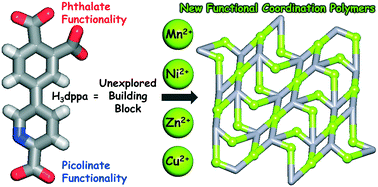Bringing 5-(3,4-dicarboxylphenyl)picolinic acid to crystal engineering research: hydrothermal assembly, structural features, and photocatalytic activity of Mn, Ni, Cu, and Zn coordination polymers†
Abstract
5-(3,4-Dicarboxylphenyl)picolinic acid (H3dppa) was applied as a novel tricarboxylic acid block with phthalate and picolinate functionalities for the aqueous-medium assembly of seven new coordination compounds, namely, [Mn2(μ-Hdppa)2(phen)2(H2O)2] (1), {[Mn(μ-Hdppa)(2,2′-H2biim)(H2O)]·H2O}n (2), [Ni(Hdppa)(phen)2]·4H2O (3), {[Ni(μ-Hdppa)(μ-4,4′-bipy)(H2O)]·H2O}n (4), {[Cu3(μ3-dppa)(μ-Hdppa)(phen)4]2[Cu(μ-Hdppa)2]·10H2O}n (5), {[Ni3(μ-dppa)2(μ-1,4-bpb)2(H2O)6]·4H2O}n (6), and {[Zn3(μ4-dppa)2(phen)2(H2O)2]·4H2O}n (7). These products 1–7 represent the first structurally characterized examples of the coordination compounds derived from H3dppa. Compounds 1–7 were assembled in the presence of various N-donor supporting ligands acting as crystallization mediators, which were selected from 1,10-phenanthroline (phen), 2,2′-biimidazole (H2biim), 4,4′-bipyridine (4,4′-bipy), or 1,4-bis(pyrid-4-yl)benzene (1,4-bpb). Full characterization of 1–7 by IR spectroscopy, thermogravimetric (TGA), elemental, and topological analyses, as well as powder (PXRD) and single-crystal X-ray diffraction, was performed. The structural types range from the discrete 0D complexes (1 and 3) and 1D coordination polymers with a 2C1 topology (2, 5, and 6) to the 2D metal–organic layers with an sql topology (4 and 7). The structural diversity of 1–7 is driven by various factors, including the metal(II) node nature, deprotonation degree of H3dppa, or type of crystallization mediator. The magnetic properties of 1, 2, 4, and 6 were studied and modeled, revealing antiferromagnetic (in 1, 2, and 6) or ferromagnetic (in 4) interactions between adjacent metal(II) centers. The luminescence of 7 was also investigated. Moreover, the photocatalytic activity of 1–7 was studied for the degradation of methylene blue as a model dye pollutant, disclosing that the nickel(II) coordination polymer 4 is the most active catalyst. The observed catalytic activity of 1–7 correlates well with their band gap energies determined by the UV-diffuse reflectance method.



 Please wait while we load your content...
Please wait while we load your content...